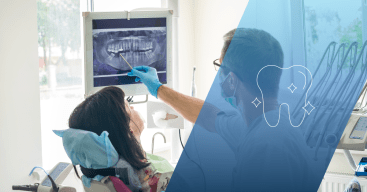Patients don’t scroll long when they look for a dentist. More often than not, they click one of the three listings at the top of Google … AKA the Google Map Pack. If your practice isn’t there, you’re losing visibility, clicks, and probably new patients.
Key Takeaways:
- The Google Map Pack captures nearly half of local search clicks, so visibility there is critical for dentists.
- Local SEO signals (your Google Business Profile, website, reviews, citations, and location) decide whether you show up.
- A complete, accurate, and active GBP is the single most important driver of Map Pack inclusion.
- Patient reviews improve both rankings and trust, especially when recent and service-specific.
- Proximity matters, but relevance (categories, keywords, FAQs) helps you appear even when you’re not the closest option.
- Consistent citations across directories confirm your credibility and strengthen Map Pack visibility.
- Hibu One enhances local SEO and Map Pack visibility.
Local search engine optimization (SEO) for dentists is a lifesaver. It’s what tells Google you’re relevant, trustworthy, and located nearby. And it’s what determines whether you show up where it counts most.
In this article, we’ll break it down:
- What the Map Pack is and why it matters
- How local SEO works for dental practices
- What really affects your ranking
- How to improve your visibility and win more local searches
Let’s dig into how to get your practice found fast.
[Related: Online Marketing for Dentists: A Beginner’s Guide]
What’s the Google Map Pack, and why does it matter for dentists?
The Google Map Pack, or the “local pack” or “3-pack,” is a block of three business listings. This block appears under the map when someone searches for a local service, like “dentist near me.”
A Google Map Pack listing shows these things:
- Business name and category (like “cosmetic dentist”)
- Star rating and number of reviews
- Location and hours
- Click-to-call button
- Link to your website
- Directions to your office
It’s the quickest way to compare options for potential patients. Because it appears above traditional website results, it grabs attention and clicks.
Being in the local 3-pack is a big deal. Businesses there see 93% more calls and 126% more traffic. Around 48% of all clicks go to a Map Pack listing.
If your dental practice doesn’t show up, searchers may never consider you, even when your website is polished and professional.
And if you wonder why your office isn’t there, inadequate local SEO is almost always the reason.
[Related: 8 Creative Ways to Increase Patient Volume for Doctors and Dentists]
Why dentists need local SEO
Dentists need local SEO precisely because of its influence on your ranking, especially your Map Pack listing. It improves your online presence so your practice shows up in the right search results.
Let’s say someone in your area searches for these types of things:
- “Family dentist in [City]”
- “Emergency dental care near me”
- “Teeth whitening [Neighborhood]”
In that case, Google uses local signals to decide which dental offices to show. Where do those signals come from?
- Google Business Profile (GBP)
- Dental website
- Patient reviews
- Online listings
- Proximity to the searcher
Local SEO bolsters the signals coming from these places, from your GBP to your website. Google is more likely to display your dental office to patients actively looking for care.
Without local SEO, Google may not see your practice as relevant. Even if you’re nearby and a great match for what the potential patient needs, you may not appear.
Google Maps and Google Search are crucial tools. More than 50% of people turn to them to find local businesses and healthcare practices.
[Related: Does SEO Matter for Your Local Business’s Website?]
5 key factors that influence which dentists show up in the Map Pack
Google considers a combination of local cues to determine which dental practices are most trustworthy, convenient, and relevant. The ones with the strongest signals are most likely to appear in the Google Map Pack.
Here are five of the most important factors that sway your ranking.
1. Google Business Profile (GBP) optimization
Your GBP is the first thing Google considers when deciding whether to show your practice in the Map Pack. That listing includes your name, address, phone number, services, photos, and more. And it serves as your digital storefront on search results and Google Maps.
Google primarily looks for completeness, consistency, and relevance in your GBP. You’ll see "relevant" and "relevance" repeatedly because Google aims for a user-first search experience.
A fully built-out GBP helps the algorithm understand key facts:
- What you offer
- Where your location is
- Whether you’re an active and trusted practice
Plus, people are 70% more likely to click a complete GBP. If your profile is incomplete, outdated, or mismatched with your website, you’re less likely to rank. That’s true even when you’re the closest dentist to the person searching.
2. Website SEO for dentists
Google cross-references your website with your GBP to confirm that your practice is legit, active, and relevant (yes, again). Your site reinforces your specialties, service areas, and authority, all of which affect your Map Pack visibility.
More website elements send ranking signals:
- On-site and behind-the-scenes keywords
- Service pages
- Fast load times
- Mobile responsiveness
The Map Pack doesn’t show website links by default. Your website is still part of what tells Google you’re a reliable local practice worth showing first.
Of course, dental SEO is important for your Map Pack visibility as well as your website’s overall ranking. Around 53% of web traffic comes from organic (non-paid) search, and SEO is what gives your website a leg up.
3. Reviews and reputation
Your online reviews (especially on Google) help Google gauge how patients feel about your dental practice. The quantity, quality, and frequency of those reviews all contribute to your local ranking.
And Google favors businesses with consistent, recent feedback. Reviews that mention specific services (like “dental crown,” “root canal”) reinforce what you do. A high rating indicates patient satisfaction.
Just as importantly, reviews build real human trust. Nearly 53% of people lean on and believe those reviews, shaping their impression of your practice.
If your practice has few or old reviews, then your chances of a high Map Pack ranking decrease. Competitors with stronger review profiles also chip away at your likelihood of ranking.
4. Proximity and relevance
Proximity plays a major role in your Map Pack ranking. Google tries to show people dentists who are physically close and contextually relevant. That is, your practice should be near the searcher and match what they’re looking for.
For example, someone who searches “pediatric dentist near me” generally sees results that combine geographic closeness and service specificity. Your GBP category, keywords, and content shape how relevant Google sees your practice.
Proximity alone accounts for 48% of the ranking influence in Map Pack services across industries. It’s another reason location is critical to that visibility.
But you can’t exactly influence where people are when they search for dental services. That’s why relevance and clarity in your online presence are equally heavy hitters.
5. Citations and consistency
Citations are listings of your dental practice information across directories, websites, and platforms. This includes your name, address, and phone number (NAP). Google uses these listings to, once again, weigh your legitimacy and confirm you’re in business.
The more consistent your practice listings are across the web, the more confidence Google has in showing you in the Map Pack. We’re talking about platforms from Yelp and Facebook to specialty dental associations and health directories.
Inconsistent citations can confuse search engines and lower your visibility.
This goes beyond Map Pack visibility and filters down to potential patients. Around 62% of users shy away from listings with inaccurate or mismatched information.
[Related: Podcast: Dr. Jordan Job, DDS talks to us about marketing strategies]
How to improve your practice’s Map Pack ranking
A big old mix of local SEO elements determine whether your dental office shows up in the Google Map Pack.
The good news if you’re not showing up? You and your digital marketing partner can strategically strengthen those five factors.
Here’s what to do to improve your dental office’s Map Pack visibility.
1. Optimize every part of your GBP
As the main driver of Map Pack inclusion, your GBP is the most important place to start. Assess your profile:
- Is it complete? Fill out all available fields, including services, business categories, appointment links, and hours.
- Is it consistent? Ensure your practice’s NAP data matches your website and other listings exactly.
- Is it localized? Use service-specific terms and location keywords (like “emergency dental care in [Neighborhood]”).
- Is it active? Add photos regularly, post updates, reply to reviews, and answer questions in the Q&A.
And Google rewards engagement. Remember that more complete and current GBPs are more likely to appear in the Map Pack for matching searches.
2. Dive into local SEO on your dental website
Your website bolsters your eligibility and ranking within the Map Pack. Take a magnifying glass to your site’s local SEO:
- Use local keywords, like “teeth cleaning in [City]” or “crown placement in [Region],” throughout your content.
- Optimize title tags, meta descriptions, and headings on core pages (your SEO specialist knows what to do).
- Create individual service pages (like for implants, Invisalign, bleaching) and, if necessary, location pages.
- Add schema (structured data) to help Google understand your practice’s address, times, and services.
- Ensure your site is mobile-friendly, fast-loading, and easy to navigate.
Google looks for consistency between your website and your GBP. With that in mind, your website should confirm what your dental GBP says (and vice versa). Even when optimized to a T, a website disconnected from your listing can hurt your Map Pack ranking.
3. Build and maintain a strong review profile
Your dental reviews play dual roles, affecting your Map Pack ranking and helping prospective patients decide to give you a call. Build up those voices:
- Request reviews after visits, ideally via text or email with a direct link.
- Encourage patients to mention the services they received (like “Dr. Patel fit me in for an emergency crown repair”).
- Aim for fresh, frequent reviews because recency is on Google’s checklist.
- Respond to all reviews professionally, including the not-so-good ones.
Patients also trust patterns. A 5-star rating from 2 years ago isn’t as compelling as 10 recent reviews that flow in weekly. And Google sees them the same way.
4. Improve relevance with smart content and categories
You can’t change where a person searches from physically, but you can increase your odds of appearing with topical relevance. These are key tips to do just that:
- Select accurate GBP categories, like “family dentist,” “oral surgeon,” or “sedation dentist.”
- Use descriptive service names in your GBP and website content, beyond just “dental services.”
- Highlight treatments and technologies unique to your practice. Think 3D imaging, anxiety relief, and after-hours care.
- Build FAQs around patient questions (like “Do I need a crown or filling?” or “Do you need braces if you get veneers?”).
Relevance (there’s that word again) makes a world of difference when you can’t wrangle proximity. A strong correlation between your profile and what people search for nudges Map Pack appearance in your favor.
5. Audit and clean practice citations
Remember how we said that your citations are fundamental to your Map Pack credibility, especially your NAP? Do a sweep of how your dental practice appears online:
- Identify which places list your practice (Yelp, Bing Places, Facebook, Vitals, Healthgrades, etc.).
- Make sure your NAP mirrors what’s on your website.
- Remove duplicate or outdated listings.
- Add your practice to high-authority dental and local directories, including any associations or insurance provider networks.
Even one out-of-date or incorrect listing can cause friction for search engines trying to validate your practice. And that can block your Map Pack visibility right at the source.
[Related: 9 Tips to Generate Organic Visits for Google Business Profile]
Local SEO plus the Map Pack: More patients, more calls
You have hands-on experience and multiple online channels. But without strong local SEO, your dental practice may never reach the 3-pack for people actively looking for care.
Search is changing fast. And Google’s AI results pull from the same local signals that influence Map Pack visibility.
Appearing in the Map Pack isn’t simply about rankings (although that’s a big, big deal). It’s about being the first choice when someone types “dentist near me” with a toothache, a nervous kid, or a cosmetic vision.
When your GBP, website, reviews, and listings all work together via local SEO, they do more than improve visibility. They create momentum, turning search traffic into new patients and new appointments.
And if this all sounds like a lot to do on your own, it is. But Hibu is here to do it all for you, so you can focus on patient care.
[Related: 5 Types of Digital Marketing That Get Results For Small Businesses]
Let Hibu handle the dental SEO
We’ve worked digital marketing wonders for dental offices like yours.
With Hibu One, you get more than Map Pack visibility strategies. You get a smart, all-in-one platform that connects your website, SEO, reviews, listings, and more. And our local digital marketing experts build and manage it all.
No stress, just valuable results. Let’s help people find your dental practice first and choose it fast.
Call 877-237-6120 for a free consultation, or request a Hibu One demo.



